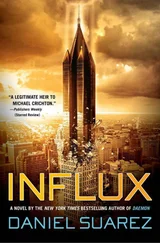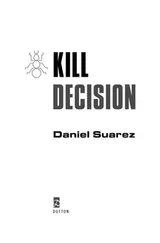“Fuck his frame of mind.”
Ross met Sebeck’s stare for a moment or two, then looked away. “Sorry. I guess that is annoying. If someone could just get me back to my car, I’d like to get some rest.”
Sebeck’s stare softened. “I forgot the Feds grilled you all last night. I’ll take you back. No detours this time.”
They turned and faced a barrier of concrete highway dividers ringing Sobol’s estate. CALDOT crews had placed them over the last several hours. Both men looked into the distance. Beyond the estate fence, a quarter mile away, the black Hummer sat motionless in the center of the sweeping lawn amid crisscrossing tire tracks. Its whip antennae stood straight up, like the spines on some deadly insect.
A few deputy sheriffs were placed here and there along the road, sitting inside rugged-looking Forest Service crew trucks, engines idling. Sebeck guessed they were there to win a demolition derby should the Hummer make a break for it.
Sebeck turned to Ross. “You really think this is just the beginning, don’t you?”
Ross scanned the terrain. “I don’t know what I think anymore. Maybe Trear’s right.”
Sebeck took one last venomous look at the Hummer. “C’mon. Let’s get you back to your car.”
Chapter 15:// Countermeasures
Crypto City. That was what they called National Security Agency headquarters. Each day thousands of agency personnel took an unmarked highway exit in Fort Meade, Maryland, into a sprawling business park of mid-rise office buildings surrounded by concentric rings of barbed wire fencing and a yawning desert of parking spaces. The mirrored windows of the buildings were fakes. Behind them sheets of copper and electromagnetic shielding prevented any electrical signals from escaping the premises.
The agency was a vast communications drift net, catching hundreds of millions of electrical and radio transmissions worldwide every hour and sifting through them with some of the most powerful supercomputers on the planet. From its very beginning—back in the days of the fabled Black Chamber after World War II—the agency was responsible for creating the cryptologic ciphers relied upon to safeguard America’s secrets and for cracking the ciphers of foreign powers.
A culture of secrecy dating back to the Cold War permeated the place. Posters seemingly from a bygone era hung in the common spaces, extolling the virtues of keeping secrets—even from other top-secret researchers. However, with the explosion of technology throughout the nineties, even the NSA was no longer able to keep up with the worldwide flow of digital information, and they were forced to let the rumors of their omniscience hide a brutal reality: no one knew where the next threat was coming from. Nation states were no longer the enemy. The enemy had become a catchall phrase: bad actors .
In a corner boardroom of the OPS-2B building, a group of agency directors convened an emergency meeting. No introductions were necessary. They had already worked together closely in the War on Terror and the War on Drugs, and they stood ready to combat any other noun that caused trouble. Senior intelligence and research officers from a periodic table of agencies were in attendance: NSA, CIA, DIA, DARPA, and the FBI. The talk was fast and urgent.
NSA: “So, what is it, a virus? An Internet worm?”
DARPA: “No, something new. Some sort of distributed scripting engine that responds to real-world events. It’s almost certainly capable of further propagation.”
NSA: “Can we write a bot to scour the Net and delete it?”
DARPA: “Not likely.”
NSA: “Why not?”
DARPA: “Because it doesn’t appear to have a single profile. Our best guess is that it consists of hundreds or even thousands of individual components spread over compromised workstations linked to the Net. Once a component is used, it’s probably no longer needed.”
NSA: “Then there’s an end to it? I mean, Sobol’s dead, so it will stop once it runs its course.”
DARPA: “True, but there’s obvious concern over the damage it might cause in the meantime. It’s already killed eight people.”
NSA: “Can’t we block its communications? Surely the components have to communicate with each other?”
DARPA: “No. They don’t. We believe the components are triggered not by each other, but by reading news stories. For example, one component just issued this press release”—he passed a printed page—“only after the siege story hit the wire services. The release is digitally signed. Sobol wants us to know it was his. We already tracked down the origin of the press release; it was e-mailed from a poorly secured computer in a St. Louis accounting firm. The program destroyed itself after it ran, but we were able to recover it from a tape backup. It was a simple HTML reader searching hundreds of Web sites for headlines about this estate siege.”
CIA: “Jesus. So we can’t stop this thing? What’s it up to?”
DARPA: “Its proximate purpose appears to be self-preservation. Its ultimate purpose is unclear. It acts like a distributed AI agent—which would make sense if Matthew Sobol designed it.”
CIA: “Artificial intelligence? You’re not serious?”
DARPA: “Let me be clear: this is not a thinking, talking, sentient machine. This is narrow AI—like a character in a computer game. It’s a collection of specific rules searching for recognizable patterns or events. Very basic. Nonetheless, very potent. It can alter course based on what’s occurring in the real world, but it can’t innovate or deviate from its given parameters. It required an incredible amount of planning. The name the press gave it is apt: it’s basically a daemon. A distributed daemon.”
CIA: “This is horseshit. There must be living people controlling it—cyber terrorists. I mean, how could Sobol know in advance exactly how we’re going to react?”
DARPA: “He didn’t have to. He could plan for multiple contingencies and then observe what actually occurs. Thus its monitoring of Internet news.”
FBI: “Just shut down the Internet.”
The others gave him a patronizing look.
FBI: “You guys built the damned thing. Why can’t you turn it off?”
NSA: “Let’s stick to reasonable suggestions, shall we?”
FBI: “I don’t mean for a long time—just for a second.”
DARPA: “The Internet is not a single system. It consists of hundreds of millions of individual computer systems linked with a common protocol. No one controls it entirely. It can’t be ‘shut down.’ And even if you could shut it down, the Daemon would just come back when you turned it back on.”
The director cut him off.
NSA: “Look, let’s not hold a remedial class on distributed networks. Let’s get back to the big question: do we defy Sobol’s demand? What can he do if we enter the estate prior to thirty days?”
CIA: “We must enter the estate—you know that.”
NSA: “Of course I do. But before I make my report to the Advisory Council, I need to know the potential consequences of defying this thing.”
Everyone looked to the scientist.
DARPA: “Based on the deaths yesterday, I’d say there will be more fatalities.”
CIA: “But nothing on a grander scale? No economic damage? No political ramifications?”
DARPA: “It’s impossible to say. We’ll only know when we defy it.”
NSA: “What about jamming the radio signals to the Hummer?”
DARPA opened a folder and flipped through it while he talked.
DARPA: “The Hummer isn’t the problem. The problem is the ultrawideband signals emanating from the house.” He distributed handouts.
NSA: “Ultrawideband? Refresh me on that.”
Читать дальше












